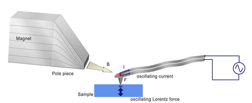Anasys report on the Lorentz Contact Resonance imaging mode now available for their afm+ and nanoIR systems
Anasys Instruments continues to expand the capabilities of their nanoscale materials characterization techniques with the Lorentz Contact Resonance (LCR) imaging mode. This is now available for their afm+® and nanoIR™ systems.
The Lorentz Contact Resonance imaging mode further enhances the capabilities of the afm+ and nanoIR systems from Anasys. LCR allows rapid broadband nanomechanical measurements over a range of temperatures. LCR imaging differentiates between multiple components of a sample and allows precise location of the probe for subsequent chemical or thermal analysis with nanoscale resolution.

Schematic to illustrate Lorentz Contact Resonance imaging
LCR provides both nanomechanical spectroscopy and compositional mapping on the highest levels of resolution. For example, analysis of wideband contact resonance spectra may readily differentiate different domains in polymer blends while the high resolution image maps provide insight to materials components in heterogeneous polymer blends.
The technique is based upon the Anasys proprietary Thermalever™ probes. LCR works by using a pole piece to focus a magnetic field onto the end of the probe. An oscillating current is then passed through the probe. The interaction between the magnetic field and the electric field causes a perpendicular force in the cantilever resulting in an oscillating behavior of the cantilever. Driving the tip in this fashion, instead of with a piezoelectric crystal, provides many advantages, including no moving parts in the drive system leading to clean cantilever resonance spectra with no parasitic peaks. Then, using the Anasys Analysis Studio software, a wide range of frequency sweeps are made (from 1 kHz to 4 MHz). By placing the Thermalever probe on the surface of a sample and sweeping the entire frequency range, we can obtain mechanical spectra of the surface. Materials with different stiffness will display different amplitudes or shifted peaks at the resonant frequencies of the cantilever.
Source: Nanotechnology Now
- 300 reads




